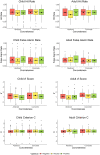Effects of Emotional Valence and Concreteness on Children's Recognition Memory
- PMID: 33343478
- PMCID: PMC7746830
- DOI: 10.3389/fpsyg.2020.615041
Effects of Emotional Valence and Concreteness on Children's Recognition Memory
Abstract
There are considerable gaps in our knowledge of how children develop abstract language. In this paper, we tested the Affective Embodiment Account, which proposes that emotional information is more essential for abstract than concrete conceptual development. We tested the recognition memory of 7- and 8-year-old children, as well as a group of adults, for abstract and concrete words which differed categorically in valence (negative, neutral, and positive). Word valence significantly interacted with concreteness in hit rates of both children and adults, such that effects of valence were only found in memory for abstract words. The pattern of valence effects differed for children and adults: children remembered negative words more accurately than neutral and positive words (a negativity effect), whereas adults remembered negative and positive words more accurately than neutral words (a negativity effect and a positivity effect). In addition, signal detection analysis revealed that children were better able to discriminate negative than positive words, regardless of concreteness. The findings suggest that the memory accuracy of 7- and 8-year-old children is influenced by emotional information, particularly for abstract words. The results are in agreement with the Affective Embodiment Account and with multimodal accounts of children's lexical development.
Keywords: affective embodiment; concreteness; lexical knowledge; recognition memory; word valence.
Copyright © 2020 Kim, Sidhu and Pexman.
Conflict of interest statement
The authors declare that the research was conducted in the absence of any commercial or financial relationships that could be construed as a potential conflict of interest.
Figures

Similar articles
-
Development of Abstract Word Knowledge.Front Psychol. 2021 Jun 7;12:686478. doi: 10.3389/fpsyg.2021.686478. eCollection 2021. Front Psychol. 2021. PMID: 34163413 Free PMC article.
-
Sensitivity to emotion information in children's lexical processing.Cognition. 2019 Sep;190:61-71. doi: 10.1016/j.cognition.2019.04.017. Epub 2019 Apr 23. Cognition. 2019. PMID: 31026671
-
Valence and concreteness in item recognition: Evidence against the affective embodiment account.Psychon Bull Rev. 2024 Aug;31(4):1570-1578. doi: 10.3758/s13423-023-02442-8. Epub 2023 Dec 27. Psychon Bull Rev. 2024. PMID: 38151693
-
Words matter: age-related positivity in episodic memory for abstract but not concrete words.Neuropsychol Dev Cogn B Aging Neuropsychol Cogn. 2020 Jul;27(4):595-616. doi: 10.1080/13825585.2019.1657556. Epub 2019 Aug 27. Neuropsychol Dev Cogn B Aging Neuropsychol Cogn. 2020. PMID: 31452464
-
The role of emotion in acquisition of verb meaning.Cogn Emot. 2024 May 3:1-8. doi: 10.1080/02699931.2024.2349284. Online ahead of print. Cogn Emot. 2024. PMID: 38700269
Cited by
-
Development of Abstract Word Knowledge.Front Psychol. 2021 Jun 7;12:686478. doi: 10.3389/fpsyg.2021.686478. eCollection 2021. Front Psychol. 2021. PMID: 34163413 Free PMC article.
-
Editorial concepts in interaction: social engagement and inner experiences.Philos Trans R Soc Lond B Biol Sci. 2023 Feb 13;378(1870):20210351. doi: 10.1098/rstb.2021.0351. Epub 2022 Dec 26. Philos Trans R Soc Lond B Biol Sci. 2023. PMID: 36571137 Free PMC article.
-
Children's suggestibility for neutral arbitrary actions in the context of norm violations.PLoS One. 2023 May 25;18(5):e0286241. doi: 10.1371/journal.pone.0286241. eCollection 2023. PLoS One. 2023. PMID: 37228049 Free PMC article.
-
Role of Affective Factors and Concreteness on the Processing of Idioms.J Psycholinguist Res. 2023 Dec;52(6):2321-2338. doi: 10.1007/s10936-023-10001-4. Epub 2023 Aug 10. J Psycholinguist Res. 2023. PMID: 37563522
-
The Attachment Mapping Protocol (AMP): An Assessment and Treatment Tool for General Psychotherapy, Systemic Family Therapy and Multifaith Spiritual Care.J Relig Health. 2023 Dec;62(6):4112-4157. doi: 10.1007/s10943-023-01881-w. Epub 2023 Sep 29. J Relig Health. 2023. PMID: 37775615
References
-
- Bääth R. (2010). ChildFreq: an online tool to explore word frequencies in child language. LUCS Minor 16 1–6. 10.1007/978-94-010-0844-0_1 - DOI
-
- Balota D. A., Yap M. J., Hutchison K. A., Cortese M. J., Kessler B., Loftis B., et al. (2007). The English lexicon project. Behav. Res. Methods 39 445–459. - PubMed
-
- Barsalou L. W., Santos A., Simmons W. K., Wilson C. D. (2008). “Language and simulation in conceptual processing,” in Symbols, Embodiment and Meaning, eds De Vega M., Glenberg A. M., Graesser A. C. (Oxford: Oxford University Press; ), 245–284. 10.1093/acprof:oso/9780199217274.003.0013 - DOI
-
- Ben-Shachar M. S., Makowski D., Lüdecke D., Kelley K., Stanley D. (2020). effectsize: Compute and Interpret Indices of Effect Size. R package version 0.4–0.
LinkOut - more resources
Full Text Sources

